What to do if the toilet cistern is leaking?
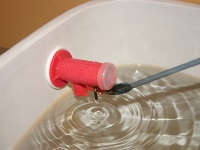
In our today's article we will talk about the main causes of leaking toilet cistern, as well as talk about ways to troubleshoot.
Causes
Detected problems with the toilet bowl, which began to leak in some places, are caused by three reasons. Sometimes separately, and sometimes provoke a breakdown by joint efforts:
- When installing new plumbing fixtures, mistakes are often made in installation, assembly.
- With prolonged use, the cistern leaks due to failed or worn structural elements, fittings. Natural breakdowns usually occur only three years after installation.
- Mechanical damage, violation of operating recommendations. This is you sudden jerks at the levers, heavy pressure on the buttons, accidental shocks, and so on.
Now let's consider several types of leaks separately.
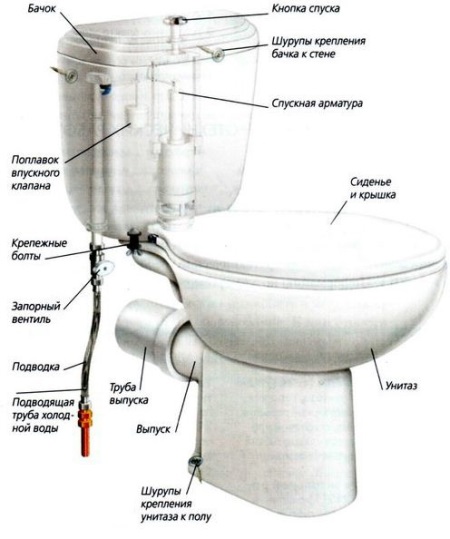
Types of leakage
When draining.
- Leaks can occur after you push the drain button. This indicates the need to check the construction of the drain system. Often the cause is a malfunctioning shut-off valve. Take hold of it with your hand, press lightly. If this helps, it means that the valve was just loose on the surface. Replace the old valve gasket with a good quality new one, and the job is done.
- Drain key is dislodged, regulator's height position is incorrect. In such situations, the valve is located higher than the drain hole. The gap formed leads to leaks. Adjust the regulator a little, try to return the button to its original position. To do this, you need to tighten the fasteners with which the tank is attached to the pipe or the sanitary product itself.
- Water leaks because of a loose nut attached to the outside of the bottom. The reason is simple - the tightness is broken. Replacing the gasket or installing a new nut with a high quality gasket will most likely help.
Remember, if the failure is minor and caused by a broken seal, then use simple sealants. For more serious problems, replace the damaged elements of the cistern.
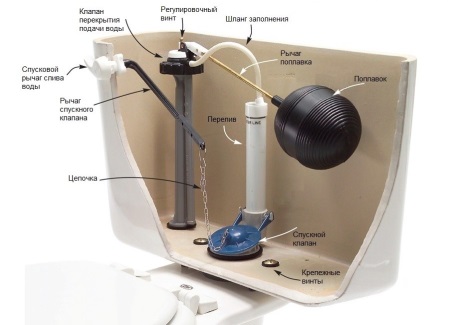
If it leaks through the overflow
First of all, check the float system lever, as well as the condition of the valve and the float itself. Sometimes water is not held inside the tank, but flows directly into the bowl through the overflow. It is possible that the lever has shifted from its original position, or a misalignment has occurred.
See if there is any liquid in the float. This is often the cause of overflow leaks. If it is really there, then the float is out of service. Bringing it back to life is simple:
- Remove the float;
- Empty the float of accumulated water;
- Dry it thoroughly, even using a hair dryer, which will speed up the process;
- Fix the cracks and holes through which water got inside. Epoxy glue comes in handy for this. If you add a little super cement to it, the quality of repair will be even higher;
- Put the element back in place.
If the valve of the float system has failed, the easiest thing to do is to replace it with a new one. This is not difficult to do:
- Bleed all fluid from the water tank;
- Disconnect the shaped part using a wrench. This connects the valve to the water supply system, i.e. the water pipe;
- Remove the lever, but be careful not to damage other elements;
- Remove the inner nut, as well as the outer nut that holds the lever;
- Remove the float valve;
- Install the new element using the retaining nuts;
- Fill the reservoir with liquid;
- Lock the lever in the correct position;
- Do a test drain, which will determine if you did everything right.
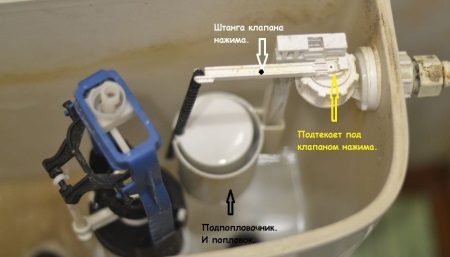
If there is a problem with the siphon membrane, it must be replaced. Solving the problem by using adhesives, sealants will not work. Buy a new diaphragm, and a similar one to the old one. Remove it, find a similar one in a plumbing supply store. To make the repair, follow the simple instructions:
- Drain the water so that there is nothing left in the drain tank;
- Use a rope to tie the float arm to some rung. The element must be securely fastened in place;
- The crossbar can be any bar, a piece of wood placed in place of the tank lid;
- Remove the nut that connects the flush pipe and tank;
- Slightly loosen the other nut, unscrewing it from the trap. It is located at the base of the tank;
- From the lever gently disconnect the siphon and pull it out;
- Now take the new membrane and put it in its rightful place;
- Assemble the entire system, acting in reverse order.
Between the cistern and the toilet bowl.
- Inspect the condition of the cuff. It will have to adjust or tighten, using a clamp. Do not overtighten the bolts, but at the same time do not make the fasteners too loose.
- If there is a corrugated area on the collar, they sometimes shift out of their original position. Clamps or plumbing insulation can help put them back in place. The latter option will give a temporary result, so a clamp is the best solution.
- The cause of this type of leak can be a weak fixing of the cistern and shelf. Check if the nuts and bolts are tightened firmly. Brass bolts last forever, while metal counterparts lose their original characteristics over time.
- If the previous option didn't work, take a closer look at the gaskets on the tank. Unscrew all the nuts, bolts, inspect the condition of the gaskets. Replacing them is not difficult or expensive.
- If the shelf is damaged, you can't help with clamps and sealants. You will need a complete replacement of the shelf or even the tank.
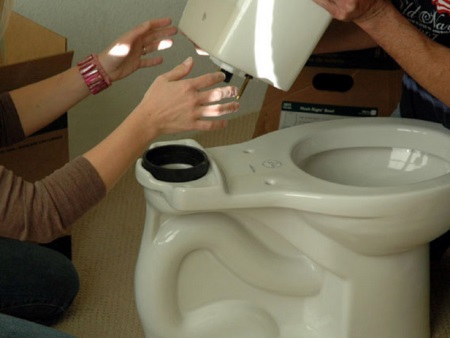
From cistern to floor.
The primary cause is poorly tightened or deformed over time and under the influence of moisture bolts:
- If they are badly torqued but the fasteners are new, just work with the proper tool and tighten the fasteners.
- If fasteners lose quality, they must be replaced. Shut off the water, drain off any residual water, partially dismantle the fittings to have more or less easy access to the bolt heads. After removing the old ones, replace them with new ones, not forgetting the rubber seals.
It is not unreasonable to use sealants on the joints. This is generally a useful thing to solve a lot of leakage problems. Relying solely on gaskets and seals is not worth it, because even the highest quality products do not always cope with the loads. An additional measure of protection in the form of sealant will prolong the life of the plumbing and make your life easier.
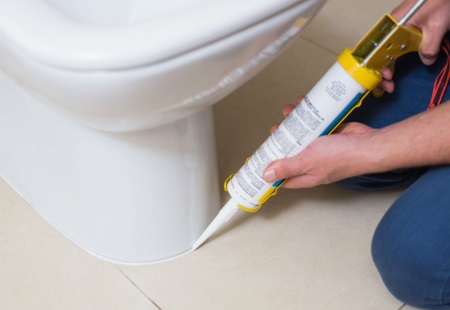
Other causes of leaks
This is not a complete list of possible leaks that occur as a result of using toilets. Let's name a few more of them, as well as ways to fix them:
- The button responsible for flushing doesn't work. Here you will need to remove the lid and check the condition of the flush system. Often the rod from the flush is coming off, as is the pressure valve. All you have to do is put them back in their places. Check if the button is dirty, clean the accumulated dirt and put it back. Problem solved.
- High noise level when pumping water. The water system can have different pressure levels. If it is high, then an increased pressure is created on the float valve and the element cannot cope with the load. As a result, increased noise. Replace a valve that can cope with such a set, or mount a stabilization valve.
If the cistern is leaking due to condensation, you need to find out the cause and fix it:
- The inlet and outlet fitting must be repaired. If it is broken, water goes into the toilet bowl, heated to room temperature readings. At the same time from the water supply is cold water, which creates condensation;
- It is necessary to reduce the volume of the drain. This is relevant for regularly operated toilets. We recommend replacing the regular drain button with a double one, where one will drain a smaller volume of liquid and the other will drain a larger volume of liquid;
- Eliminate high humidity in the room itself. If it is a combined bathroom, it will be more difficult. You can put an electric towel rail, plus be sure to provide an effective ventilation system.
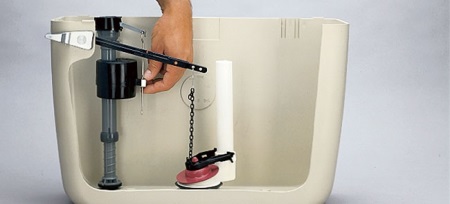
Inspection by a professional
These recommendations will allow you to figure out the causes of leaks yourself, as well as fix them, without resorting to the help of specialists. But is it worth it?
Many people prefer professional help when their plumbing fails. The benefits of a professional inspection are as follows:
- A specialist can pay attention to things you would never look at;
- Professional experience allows him to quickly find the causes of failure, qualitatively fix them;
- The master has his proven places to buy plumbing fixtures and accessories;
- A responsible specialist uses professional tools, reliable sealants, because he is interested in positive feedback on his work;
- Before installation, a professional will be able to point out the weaknesses of the pipeline, help install, connect the toilet bowl, offer his services for the prevention and maintenance of plumbing.
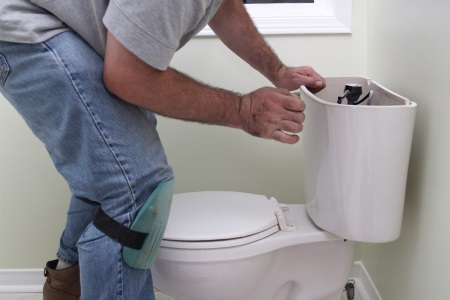
Prevention
It is better to prevent a breakdown at the stages of its emergence, than to eliminate the consequences later. By implementing preventive measures, you will significantly extend the life of your plumbing and will spend considerably less money when some problems arise.
Preventive measures include:
- Periodic inspection of joints, connections;
- Inspection of gaskets, the condition of spigots and pipes;
- Careful use of levers and flush buttons, providing no sudden pressure;
- The installation of filters, which prevent impurities, large particles that can contaminate and clog the system, from entering the cistern;
- The use of quality fittings when replacing elements of the toilet bowl;
- The use of high-quality sanitary ware, the purchase of which by itself guarantees a longer trouble-free life than products of dubious manufacture;
Appealing to professionals to solve problems and malfunctions.




